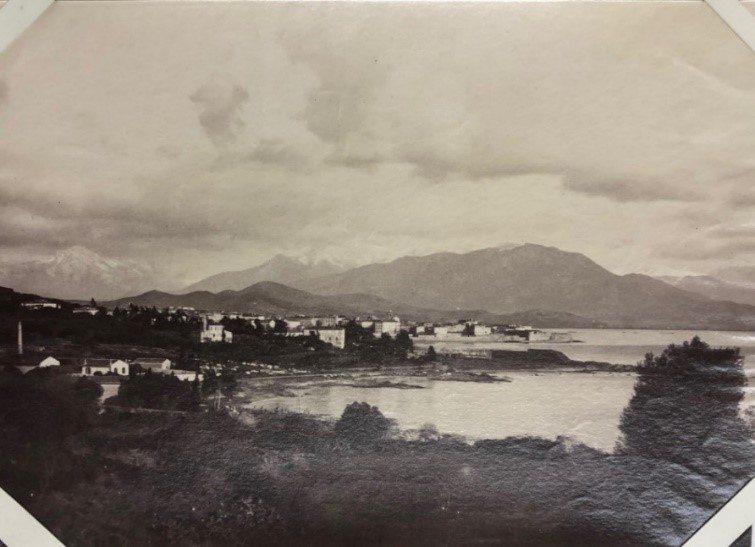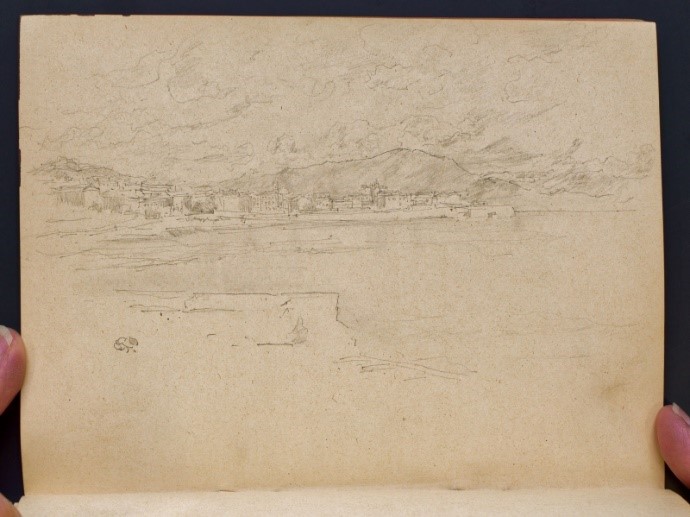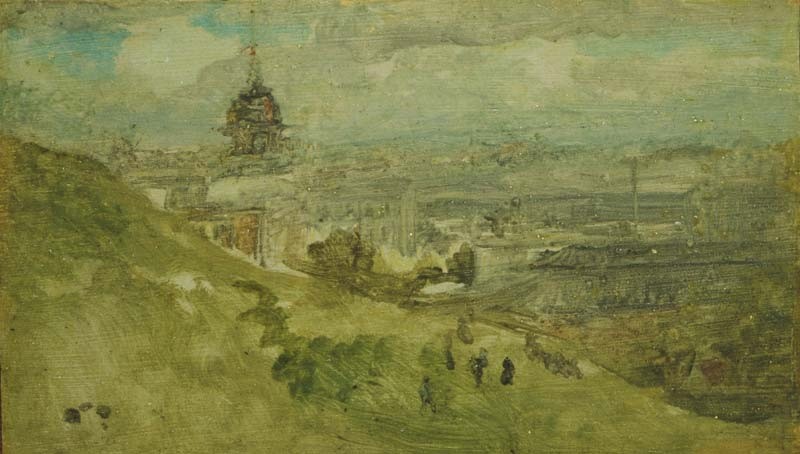
At the end of 2020 Professor Margaret F. MacDonald and Dr Grischka Petri presented a major new online publication: James McNeill Whistler: The paintings, a catalogue raisonné. Ranging from small sketches to full-length oil portraits, the collection made available through this free resource is both beautiful and fascinating, and throws new light on Whistler’s body of work. This post provides a peek behind the scenes on both the technical and cultural aspects of this work, as Professor MacDonald and Dr Petri reflect on the years of research that inform this significant publication.
A catalogue raisonné is a descriptive catalogue of works of art with explanations and scholarly comments: so saith the dictionary. The first Whistler paintings catalogue raisonné was published by Yale University Press in 1980, but a lot has changed since then! First, we had to find the pictures and see them, if possible; measure, describe them fully, obtain illustrations, investigate history, date works and decide what is authentic. Then we ‘just’ create a template, write entries (anything from 100 to 5000 words), construct a database and user-friendly website…and it all looks so easy!
So where did we start? In Glasgow! Among The Hunterian’s treasures are the works left in Whistler’s studio at his death in 1903, given to the University of Glasgow by his sister-in-law Rosalind Birnie Philip in 1935, or bequeathed in 1958. These include drawings, prints, paintings, and, remarkably, a dozen sketchbooks. From St Petersburg in the north to Algiers in the south, Whistler recorded the sites and incidents of daily life.

The Whistler Journal, Philadelphia, 1921, repr. f.p. 208.
In 1901, the 66-year-old artist, suffering the delayed effects of the influenza that raged through Europe (sound familiar?) sought the sun, but freezing winds in Tangiers and blizzards in Marseilles drove him to Corsica, “Napoleon’s Island”, where spring finally arrived in April: “and now today – it is simply amazing! 40 – degrees – out of doors in shade” as he told Rosalind.
Ajaccio, on the west coast, was a popular winter resort for wealthy tourists. Whistler stayed at the Hotel Schweizerhof on the Boulevard Sylvestre Marcaggi, which led down to the bay. In a little notebook, bound in daisy-patterned paper, he made a quick pen and ink sketch of a young woman at dinner in the hotel.

The Hunterian, Acc. no. GLAHA 46302 (M.1666).
The thin gilt-edged paper with its blue-squared lines is browned and fragile. Several other pencil sketches in this book are barely visible and are not easy to record or photograph. How do you catalogue something so fragile? Well, first, after discussions with conservators and curators, you wash your hands!
We set up our camera stand on a stable table, moving it around to find the spot where we would get the best possible light, and no shadows on the notebooks. Then we took photographs of our colour-checker card (these serve as a model to get the colours as correct as possible upon post-processing). We photographed the covers and page after page, very carefully so that the spine would not be put under pressure. Often Margaret’s fingers can be seen gently holding down a page: of course we wanted the notebooks to lay as flat as possible. After each session, we would crop the images, rotate them if they were upside down, and adjust the colours before saving them in the JPEG format used on the website. These images help the conservation department, because they make the sketchbooks’ contents accessible without having to handle them.

The Hunterian, GLAHA 49929 (G.485)
Whistler had bought a cheap exercise book with a flowery cover, now sadly battered. It has 120 pages of thin browned wove paper, some used for drafts of letters, figure sketches, ideas for an advert for Pear’s soap (Eve tempting Adam with soap!), and five drawings of Ajaccio itself. The most elaborate, reproduced below, is a detailed drawing in sharp-pointed graphite pencil, showing the whole bay and hills beyond.
A similar view, from a higher vantage point, appears in an album of old photographs (owned by a prviate collector) recording a Mediterranean trip by an unknown traveller about 1895/1900. Another drawing records ships drawn up on the beach, while one of the photographs shows ships by the quayside whence Whistler eventually departed, on 1 May. He told William Heinemann, ‘We have had storms & storms! … but things are pretty – – – only I am doing nothing! – and am so much better!’, and he brought back with him drawings, etchings, watercolours and oil paintings.

‘The Port of Ajaccio’, photograph 
‘The Port of Ajaccio’, sketchbook 
‘The harbour, Ajaccio’, photograph 
‘Ships in the harbour’, graphite pencil, Sketchbook,
p. 29, The Hunterian, GLAHA 46306 (M.1693)
Only three oil paintings survive from the trip to Corsica: a portrait of a child – he complained of “little ragamuffins who are entirely too wild to sit!” – and two small panels with views from the hills sheltering the city. A Distant Dome was neither exhibited nor recorded in Whistler’s lifetime. It shows the dome of the Cathédrale Notre-Dame de l’Assomption de Ajaccio (Cathédrale de l’Assomption de Sainte-Marie), painted from the hill of Salerio near the Parc Balestrino.

Birnie Philip Bequest, GLAHA 46392. Oil on wood. 127 x 217 mm
The support is a thin wooden panel, probably mahogany, primed in light grey paint, which remains visible, forming part of the colour harmony. It looks as if it was painted in one session: the brushwork is very free and fresh, and, while it was still wet, details were added with a tiny, pointed brush. Finally, a summary butterfly – evolved from Whistler’s monogram, JW – was painted at lower left. At the edges, the paint has been compressed, suggesting that, before it had dried, it was slid into a paintbox for transport. Whistler often carried around a paintbox, as well as copper plates and etching tools, or pencils and sketchbooks, ready for work.
The University of Glasgow is very fortunate to harbour such a collection, and it has been a challenge and a pleasure to put these lovely works online for everyone to see. ENJOY!
Margaret F. MacDonald, D. Litt. is Professor Emerita at the School of Culture and Creative Arts, University of Glasgow. Dr Grischka Petri, Ph.D, University of Bonn, is an Honorary Research Fellow at the University of Glasgow. Both have been involved with research on Whistler and his circle for a considerable time! Work on this catalogue started many years ago, backed by the generosity of the University of Glasgow’s Chancellor’s Fund, and the Leverhulme and Lunder Foundations.
Notes
Margaret F. MacDonald, Grischka Petri, James McNeill Whistler: The paintings, a catalogue raisonné, University of Glasgow, 2020, website at http://whistlerpaintings.gla.ac.uk. The Corsican oil paintings are catalogued as YMSM 544, 545 and 546; the sketchbooks are recorded at M.1666 and M.1693. Quotations are from Whistler to R. B. Philip, [3 April 1901] and 25-27 February [1901], and to W. Heinemann, 16 April [1901], in The Correspondence of James McNeill Whistler, 1855-1903, edited by M. F. MacDonald, P. de Montfort and N. Thorp, On-line edition, University of Glasgow, 1904, at http://www.whistler.arts.gla.ac.uk/correspondence (GUW 4801, 4793, and 8543).
Publications of interest include: Margaret F. MacDonald, Grischka Petri, Meg Hausberg, and Joanna Meacock, James McNeill Whistler: The Etchings, a catalogue raisonné, University of Glasgow, 2012, on-line website at http://etchings.arts.gla.ac.uk and Margaret F. MacDonald (ed.), The Woman in White: Joanna Hiffernan and James McNeill Whistler, New Haven and Washington, 2020.


well done – what a good choice for an introduction
I came across and acquired a unique, antique pen and ink sketch in a local consignment shop. It caught my eye for many reasons, but I cannot get past what is eerily similar to pieces by Whistler at this time. Is there some way to see if my hunch is right? Or if you can point me in the direction of possibly finding out who the artist might be, I would greatly appreciate it.